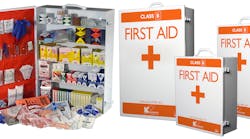Nearly 13,000 American workers are injured on the job each day. That, says the National Safety Council in its Injury Facts, adds up to 4,700,000 workplace injuries per year and 99,000,000 production days lost to workplace injury.
If you’re looking for a simple way to raise safety awareness this month – National Safety Month – and keep your employees safe all year long, a great place to start is the American National Standards Institute (ANSI) Z308.1, which helps employers comply with U.S. Occupational Safety & Health Administration (OSHA) first aid requirements, says Todd Howe, product management manager, Lawson Products (www.lawsonproducts.com).
Lawson Products is an industrial distributor of a comprehensive line of maintenance and repair products, and provides inventory management services to the industrial, commercial, institutional and government maintenance, repair and operations (MRO) market.
New Standards
Howe notes that new standards for workplace first aid kits and supplies went into effect in June 2016.
“In case you missed this, one of the most significant changes is the introduction of two classes of first aid kits, based on the assortment and quantity of each item, work environment and level of hazards,” he says. “In addition, many first aid supplies previously identified as being recommendations are now required in the updated standard, ANSI Z308.1-2015.”
Class A kits include items designed for the most common types of workplace injuries, he says. Class B kits include a broader range and quantity of supplies for injuries in more complex or high-risk environments where personal protective equipment is required.
“Start with a professional inspection of your first aid cabinets and a compliance assessment of your work areas compared to the new ANSI standards,” advises Lawson Products’ Howe. “By expanding the items on the basic first aid kit, employees have greater access to items needed to treat common workplace injuries, such as cleaning minor cuts or scratches, treating a minor burn, removing debris from the eyes and treating heat related illness.”
Heat-Related Illness
Howe of Lawson Products says OSHA data finds that 2,630 workers suffered from heat illness and 18 died from heat stroke and related causes on the job in 2014.
“The good news is that heat-related illnesses and deaths are preventable,” he says. The body normally cools itself by sweating, he explains.
“During hot weather, especially with high humidity, sweating isn't enough,” Howe says. “Body temperature can rise to dangerous levels and you can develop heat-related illnesses.”
He says these illnesses can include:
- Heatstroke – A life-threatening illness in which body temperature may rise above 106 degrees F in minutes. Symptoms include dry skin, rapid, strong pulse and dizziness.
- Heat Exhaustion – An illness that can precede heatstroke. Symptoms include heavy sweating, rapid breathing and a fast, weak pulse.
- Heat Cramps – Muscle pains or spasms that happen during heavy exercise.
- Heat Rash – Skin irritation from excessive sweating.
“Any employee exposed to hot and humid conditions is at risk of heat illness, especially those doing heavy work tasks or using bulky protective clothing and equipment,” Howe notes. “Some employees might be at greater risk than others if they have not built up a tolerance to hot conditions, including new employees, temporary employees or those returning to work after a week or more off. All employees are at risk during a heat wave.”
Employees suffering from heat exhaustion are at greater risk for accidents, he points out, “since they are less alert and can be confused. Having a serious injury or death occur at your workplace affects everyone at the organization.”
Plan Ahead
Howe of Lawson Products says National Safety Month is a great time to establish a complete heat illness prevention program, one that includes planning for emergencies, training employees on prevention and monitoring employees for signs of illness. Start by ensuring that shops have:
1. Plenty of hydration stations with water and electrolyte replacement drinks, such as Sqwincher.
2. Shaded or air conditioned areas available for breaks and if employees need to recover.
3. Taught employees the common signs and symptoms of heat illness.
4. Reminded employees of the importance of drinking water frequently, even when they are not thirsty.
5. Communicated to employees who should be notified if there is an emergency and that it is in everyone’s best interest to report symptoms early.
“You may also consider providing your employees with cooling products, such as Chill-Its cooling wrist sweatbands, towels, vests and hats,” Howe adds. “In addition, starting work earlier and ending earlier, or adding more scheduled breaks during heat waves, are options for consideration.”




